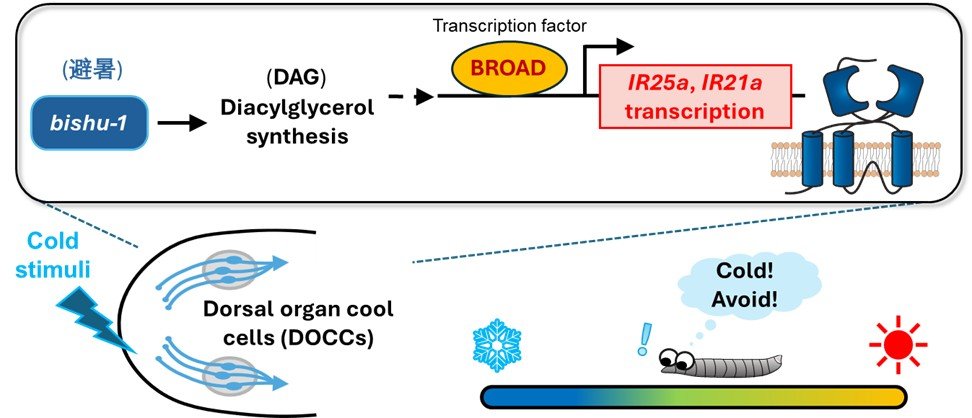|
Researchers from the National Institute for Physiological Sciences/the Exploratory Research Center on Life and Living Systems (ExCELLS)/the Graduate University for Advanced Studies (SOKENDAI) in Japan have identified a monoacylglycerol acyltransferase-coding gene named bishu-1. It is involved in the thermal responsiveness of cool temperature-sensing neurons by regulating ionotropic receptor expression, thereby maintaining the cool temperature avoidance behaviors in Drosophila larvae. |
Okazaki, Japan – Sensing environmental temperature is crucial for the development and survival of animals. Insects such as fruit flies have evolved a particularly delicate thermosensory system that can discriminate temperature changes within a milli-degree per second. This accurate thermosensation relies on the precise maintenance of thermal receptor functions; however, their activation and regulatory mechanisms have remained unclear. In this study, researchers identified a lipid enzyme that maintains the expression level of thermal receptors and modulates cool temperature sensation and avoidance behavior.
Thermal receptors called ionotropic receptors (IRs), specifically IR25a and IR21a, function in cool temperature-sensing neurons in larval head, known as dorsal organ cool cells (DOCCs), to mediate cool temperature avoidance. This behavior is affected by expression changes of IR25a and IR21a, but the underlying mechanism has been unknown. Takaaki Sokabe and his colleague Xiangmei Deng at the Exploratory Research Center on Life and Living Systems (ExCELLS) identified a monoacylglycerol acyltransferase (MGAT)-coding gene named bishu-1 as an important factor for maintaining the transcriptional level of IR25a and IR21a and the cooling responsiveness of DOCCs, thereby enabling the cool temperature sensation and avoidance. They recently published their findings in Communications Biology.
“The finding of bishu-1 was coincidental. MGATs are well known for their role in the energy storage processes in liver or intestine, so we didn’t expect an essential role of its coding gene bishu-1 in thermal sensation initially,” says Deng. “After observing that the mutants seemingly avoided warm temperatures, we gave a new name to the gene, bishu, which is a Chinese word for ‘summering’, describing the escaping behavior of larvae from heat.”
Unlike other known lipid enzymes that have more direct interactions with sensory receptors through binding with their lipid metabolites or propagation of the physicochemical properties of the cell membranes, bishu-1 regulates the expression of receptor genes: bishu-1 proved important for the expression of transcription factor broad, which binds to the regulatory region of IR25a gene. Indeed, broad overexpression was sufficient to rescue the bishu-1 mutant’s defects in cooling responses in DOCCs and cool temperature avoidance behaviors in larvae.
“Regulation of gene expression levels represents a novel role for lipid metabolism in the nervous system,” Sokabe says. “broad is widely expressed in neurons, and numerous studies have reported the function of IRs in chemical, thermal, and humidity sensation. Since we have identified other MGAT-coding genes tandemly clustered on the genome, it will be interesting to examine how these lipid enzyme-mediated mechanisms affect multiple sensory processes.”
This work could promote the discovery of lipid-mediated treatment for maintaining thermosensation and other sensory systems in humans.
bishu-1 synthesizes diacylglycerol and maintains the expression of the transcription factor broad. broad binds to the regulatory region of cool receptors IR25a and IR21a to maintain their expression. In wild-type larvae, this mechanism preserves cold avoidance behavior. Disruption of bishu-1 leads to reduced responsiveness of cooling-sensitive neurons (DOCCs) through decreased expression of broad and IRs, causing larva to remain at cool temperatures. Based on this mutant phenotype, we named the gene bishu, which is a Chinese word for “summering”.
The article, “Monoacylglycerol acyltransferase maintains ionotropic receptor expression for cool temperature sensing and avoidance in
Drosophila” was published in
Communications Biology at DOI
https://doi.org/10.1038/s42003-025-08154-0.
6116
